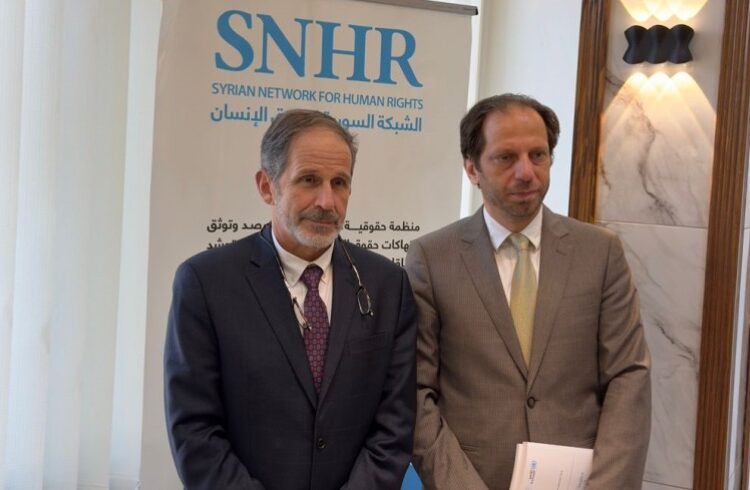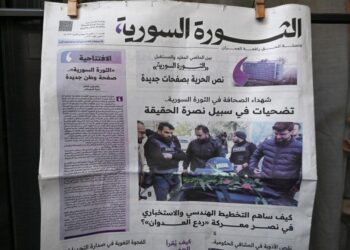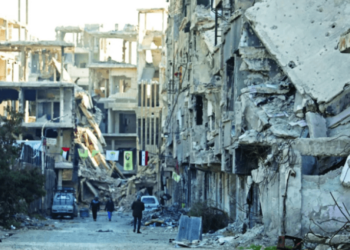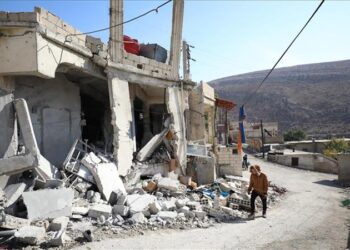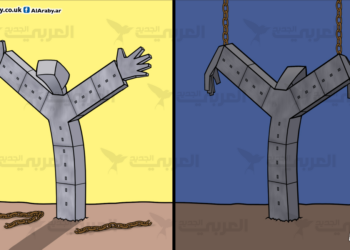Fadel Abdulghany
Robert Petty, head of the International, Impartial and Independent Mechanism (IIIM), visited the Syrian Network for Human Rights (SNHR) office and presented me with a hard copy of the Arabic translation of the extensive report (approximately 300 pages) prepared by the mechanism on the Assad regime’s detention and torture system. We, at SNHR, contributed a significant amount of supporting documents and data.
Unfortunately, the release of the English version in December 2024 coincided with the fall of the regime, preventing it from receiving the coverage and discussion it deserves, despite its importance and the significant efforts expended on its development. With the recent release of the Arabic version, I resolved to write about this important report, and this extensive article was born.
A Shocking Toll of Enforced Disappearances and Torture Victims
The Arabic version of the International, Impartial and Independent Mechanism’s (IIIM) report on the Syrian government’s detention apparatus has finally been released. Based on 501 interviews and a structural analysis of 128 detention facilities across the country, the findings reveal how the Syrian detention structure has been transformed from a criminal justice system into a sophisticated mechanism for political violence. The report analyzes the implications of these findings for understanding state repression, international law, and the structure of systematic human rights violations in contemporary conflicts. The report includes statistics from the Syrian Network for Human Rights (SNHR) for the period covered, i.e., before they were updated following the fall of Assad. Since 2011, the SNHR has documented the regime’s arrest and release of approximately 1.2 million citizens, while at least 135,253 individuals, including 3,691 children and 8,473 women, remained detained and/or forcibly disappeared as of March 2023. The network also documented 15,038 deaths under torture at the hands of regime forces between March 2011 and March 2023, including 190 children and 94 women, while always emphasizing that these numbers represent the minimum possible to document.
From Criminal Justice to Political Repression
The Assad detention system represents a fundamental deviation from the purposes of public authority. What was intended to be a tool for law enforcement and judicial procedures has been deliberately reshaped into a tool for political control. The patterns of arrest, transfer, interrogation, and detention practices in the Assad regime’s facilities reveal a coherent strategy: using detention not to prosecute crimes according to legal standards, but to suppress dissent through systematic violence. This transformation is evident in the operational consistency between centers, the continuity of practices over time, and the bureaucratic coordination between agencies. The system operates on the principle of political triage rather than individual justice. Citizens are categorized under vague labels such as “opposition” or “terrorist” and then subjected to detention strategies designed to extract confessions, gather intelligence, and impose state terror. The detention apparatus thus becomes the primary vehicle through which the Syrian state inflicts pain, extracts compliance, and expands its capacity for violence to encompass a wider segment of society.
The 2012 Terrorism Law and its specialized judicial system provide legal cover for this repressive apparatus. These structures deliberately blur the lines between emergency governance and counterterrorism, creating a quasi-exceptional state administered through coercion. The public prosecution’s powers to extend pretrial detention on security grounds indefinitely, along with military field courts exempt from normal procedural rules, and the routine acceptance of confessions extracted under duress, combine to create a legal environment in which violence becomes procedurally legitimate. This is not merely a failure of judicial independence or a collapse of the rule of law; it is the conscious construction of a parallel legal universe in which procedural safeguards are systematically replaced. Counterterrorism and military courts function as conveyor belts for political persecution, providing a veneer of formal legitimacy for organized state violence. Defense rights exist only in name, and torture allegations do not lead to serious investigations. Judges believe confessions extracted under conditions that violate all principles of voluntary testimony.
Institutional Coordination as State Policy
The effectiveness of the Syrian detention system as a tool of repression stems from its institutional integration. Security agencies, the Ministry of Interior, multiple judicial authorities, and pro-government militias operate as a coordinated unit, not as independent institutions. This coordination is manifested through central directives, shared “wanted” lists distributed at checkpoints, and synchronized arrest campaigns sweeping targeted communities.
Documentary evidence reveals meetings and circulars issued by central coordination bodies that direct interagency operations. These directives divide sectors, reorder detention priorities, and ensure uniform practices across the detention network. The Ministry of Interior consolidates the civilian aspect of the apparatus by operating prisons and checkpoints and cooperating seamlessly with intelligence branches. This institutional synchronization closes the loop between field arrest, pretrial detention, interrogation, and judicial proceedings, creating a complete cycle of state violence. Transfers between facilities further demonstrate this coordination. Detainees are transferred with warrants and interrogation summaries that enable serial interrogations and repeated coercion in multiple locations. Each transfer is not an administrative necessity, but rather an opportunity for renewed violence, as various actors extract additional information, identify new targets, and exacerbate the trauma inflicted on detainees.
The harm inside Syria’s detention centers follows predictable patterns that reveal deliberate design rather than random brutality. Overcrowding reaches breathing-impairing limits; deprivation of food and water drives bodies to their biological limit; hygiene conditions collapse to the point of disease proliferation; and medical care is systematically withheld, even in life-threatening situations. These conditions are not the product of a lack of resources or the necessities of war, but rather tools adapted to produce suffering.
Methods of physical and psychological torture across various facilities appear sophisticated and standardized; selected based on their ability to break resistance while leaving minimal visible traces, or conversely, to inflict maximum visible harm as a deterrent message. The consistency of these practices across space and time points to training, supervision, and quality control—characteristics of institutional policies rather than individual transgressions.
Interrogation practices also reveal their true purpose through their methods and objectives: they focus less on proving the facts of specific crimes than on extracting confessions to pre-prepared charges, identifying additional targets for arrest, and breaking the will of perceived opponents.
The information sought is often devoid of investigative value; interrogation sessions are used to implicate others, weave networks of suspicion, and generate raw material for further persecution.
Death in custody is a predictable consequence of the design of this system; the combination of starvation, untreated illness, medical neglect, and direct violence produces widespread mortality. However, death does not end state control; military hospitals engage in concealment, falsification of death certificates, and the disposal of remains in ways that deny families the truth and obscure the circumstances of death. This administrative violence, the bureaucratic erasure of the facts of death, represents a final assertion of state power over both the living and the dead.
The scale of deaths in detention centers transcends individual tragedy to demographic violence, with entire communities losing large numbers of adults, creating social voids that extend across generations. The systematic nature and predictability of these deaths under conditions of detention, coupled with the state’s efforts to conceal them, constitute evidence not of negligence but of intent—the calculated acceptance of mass death as a tool of political control.
The involvement of medical institutions in this system deserves particular condemnation. Military hospitals, supposedly treatment centers, have become pivotal nodes in the concealment apparatus, producing forged documents and facilitating the disappearance of bodies. Medical professionals, ethically charged with protecting patients’ safety, participate in torture through selective denial of treatment and medicalization of violence.
This complicity goes beyond individual ethical failings to systemic institutional corruption: hospital administrators coordinate with security agencies, medical records are routinely falsified, and the entire healthcare infrastructure within the detention system operates according to political, rather than therapeutic, imperatives.
International Legal Implications
The Assad regime’s detention regime challenges fundamental assumptions about state sovereignty and the limits of its authority over its citizens. Transforming the criminal justice infrastructure into a tool of repression violates numerous provisions of international human rights law and extends to the entire framework of legitimate governance under international law. When detention is divorced from any genuine judicial purpose and becomes merely a mechanism of violence, it loses its status as a legitimate exercise of state power. The systematic nature of these violations, including their coordination across agencies, their continuity over time, and their geographical scope, rises to the level of crimes against humanity.
The detention system operates as a widespread and systematic attack on the civilian population, with knowledge and intent, as evidenced by the bureaucratic structure and policy documentation. Every arrest, transfer, interrogation, and concealed death are not isolated incidents, but rather integral parts of a systematic campaign of persecution.
Assad’s detention system has thrived on pervasive impunity at all levels. Guards who commit torture have never faced prosecution; officials who orchestrate the transfer of detainees for further abuse operate within routine bureaucracies;
Judges who accept coerced confessions continue their careers; doctors who falsify death certificates operate without accountability. This impunity is not accidental; it is a functional necessity; obstructing accountability makes violence sustainable. Therefore, international justice mechanisms should focus not only on the top leadership but also on the entire network of participants.
Conclusion
The Assad detention system represents a stark example of how authoritarian regimes weaponize state institutions against their own societies. The repurposing of the criminal justice infrastructure as a machine for political violence is not a failure of the state, but rather a conscious design—a deliberate choice to rule by terror rather than legitimacy. The complexity of this system, its bureaucratic coordination, and its persistence over time reveal a fundamental relationship the government establishes with its citizens: not as a sovereign authority protecting its people, but as a repressive force acting as an occupying power over a subjugated society.
For practitioners of international law and policy, this system offers crucial lessons about the link between institutional design and systematic violence. When legal frameworks provide cover for torture, bureaucratic procedures facilitate concealment, and medical institutions participate in cover-ups, individual atrocities accumulate into structural violence.
The evidence from Syrian detention centers should prompt a radical rethinking of how international law conceptualizes and responds to systematic detention-based violence. Current frameworks, primarily designed to address conventional warfare and genocide, struggle to accommodate the horror of a state that transforms its entire detention system into an instrument of political persecution. As the Syrian case clearly demonstrates, when detention becomes a weapon of war, the traditional boundaries between combatants and civilians, battlefield and prison, war and governance collapse, resulting in a unified reality of systematic state terror.
